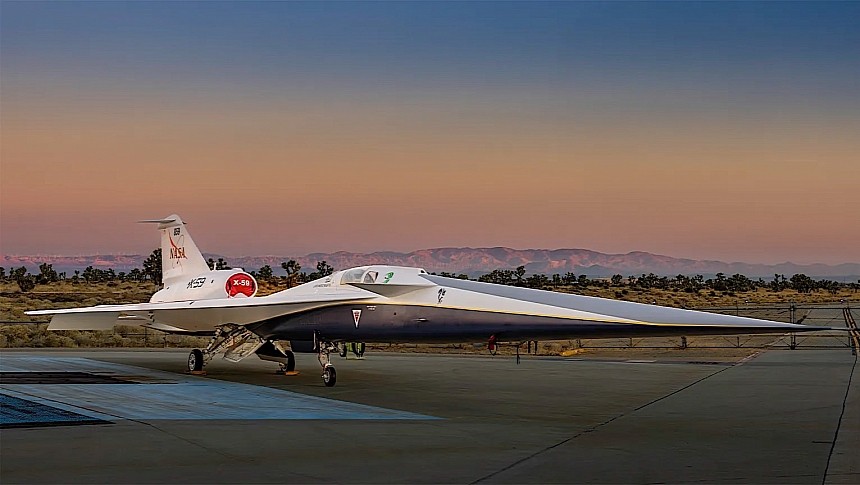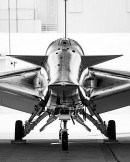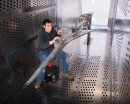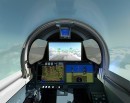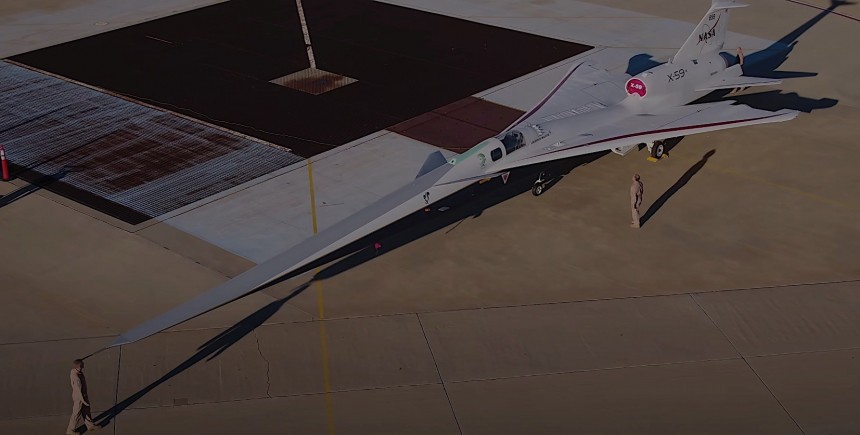If you ask me, some of the best sci-fi movies are the ones where humanity has to fight for its survival against some technologically advanced alien race, preferably in the far reaches of space. And many of the fighter spacecraft sent against us by malicious races look out right deadly.
And that's kind of the same feeling one gets looking at the newest experimental aircraft built for NASA by Lockheed Martin. An amazing sight of a machine that was put together more or less from scratch in less than a decade to possibly forever change the shape of aviation.
The aircraft is called X-59, and it is part of the NASA Quiet Supersonic Technology (QueSST) program, an effort meant to make supersonic flight, civilian or otherwise, possible over populated areas. And, as promised, it was shown in full at the end of last week during a roll-out ceremony like NASA used to hold back in its early days for space exploration gear.
Because the project has been around for eight years now (initial design began back in 2016) and thanks to the many renderings and other related images of the aircraft we've been treated to over the past years, we had a pretty good idea of how the X-59 is going to look. That didn't diminish in the slightest the awe we felt when first setting our eyes on the real thing.
The thing looks like a knife meant to slice through butter, at least from the side. A very long, pointed nose leads the charge against the air it's going to fly through, rising slightly as it moves to the center of the plane, where the cockpit is. Then the silhouette drops again, only to abruptly end in the intake for the plane's engine.
Seen from above the X-59 looks like two planes fitted on top of one another, and then giften with a snout so long it's like a knight's spear.
The veeeery long nose of the X-59 is gifted with two small wings close to the middle of the plane, where the cockpit is located. It is here where the first aircraft seems to begin, looking like a delta-wing flying machine.
The cockpit is located here, almost halfway down the aircraft, something that doesn't regularly happen. What's truly stunning about it is that it has no front window. That's right, pilots won't see outside in the usual fashion but will experience the world through something called the eXternal Vision System – a series of external cameras that feed a 4K screen installed inside.
The elevated rear section, where the engine and stabilizers are located, gives one the impression they're looking at a second aircraft slapped upon the first, this one missing its front end entirely.
The strange shape of the aircraft is owed to the mission it is meant to perform. Its pointy front, its curves, and pretty much everything else are meant to separate the shocks and expansions of air associated with supersonic flight, which are responsible for generating sonic booms.
You see, in a normal supersonic aircraft, like say an F-16, the pressure waves created during flight merge into one. Due to a play of pressure, once an aircraft blasts through these pressure waves, a sonic boom occurs. Which, in the case of the F-16 I mentioned, can be as loud as 78 dB at an altitude of over 8,000 meters (26,200 feet).
Because of this supersonic flight is forbidden over land, and it has been so ever since 1973, when U.S. regulators stepped forward to protect the nation's ears and windows.
The X-59, through its design, is meant to lower the value of the sonic boom to as little as 60 dB, which is about as loud as a car door closing or a casual conversation with a friend.
Despite the mission it was bestowed with, the X-59 is no toy. The engine mounted high up on the tail is a GE Aviation jet of the F414-GE-100 variety, capable of developing 22,000 pounds of thrust. That should give it enough punch to travel at speeds of Mach 1.4 (925 mph/1,488 kph ) and altitudes around 55,000 feet (15,240 meters).
The bulk of the plane is rather small in size, but the long front end more than makes up for it, as it accounts for almost a third of the plane's total length. From front to rear it measures almost 100 feet (30.4 meters), and from wing tip to wing tip 30 feet (9.1 meters).
It's a silhouette the residents of some American cities will get to experience first-hand. After ground tests and the first flight take place by the end of the year, NASA plans to begin testing the plane over populated areas and see exactly how the reduced sonic boom it generates is felt by humans.
Once enough flight data is generated, the space agency plans to share it with regulators so that they may decide on whether to amend the rules on supersonic flight over land should some aircraft makers choose to adopt the ideas developed under QueSST.
The plane will operate from the NASA NASA's Armstrong Flight Research Center in Edwards, California. It was put together by Lockheed Martin's Skunk Works as a unique experimental airplane, and it will not result in some sort of production version.
The aircraft is called X-59, and it is part of the NASA Quiet Supersonic Technology (QueSST) program, an effort meant to make supersonic flight, civilian or otherwise, possible over populated areas. And, as promised, it was shown in full at the end of last week during a roll-out ceremony like NASA used to hold back in its early days for space exploration gear.
Because the project has been around for eight years now (initial design began back in 2016) and thanks to the many renderings and other related images of the aircraft we've been treated to over the past years, we had a pretty good idea of how the X-59 is going to look. That didn't diminish in the slightest the awe we felt when first setting our eyes on the real thing.
The thing looks like a knife meant to slice through butter, at least from the side. A very long, pointed nose leads the charge against the air it's going to fly through, rising slightly as it moves to the center of the plane, where the cockpit is. Then the silhouette drops again, only to abruptly end in the intake for the plane's engine.
Seen from above the X-59 looks like two planes fitted on top of one another, and then giften with a snout so long it's like a knight's spear.
The veeeery long nose of the X-59 is gifted with two small wings close to the middle of the plane, where the cockpit is located. It is here where the first aircraft seems to begin, looking like a delta-wing flying machine.
The elevated rear section, where the engine and stabilizers are located, gives one the impression they're looking at a second aircraft slapped upon the first, this one missing its front end entirely.
The strange shape of the aircraft is owed to the mission it is meant to perform. Its pointy front, its curves, and pretty much everything else are meant to separate the shocks and expansions of air associated with supersonic flight, which are responsible for generating sonic booms.
You see, in a normal supersonic aircraft, like say an F-16, the pressure waves created during flight merge into one. Due to a play of pressure, once an aircraft blasts through these pressure waves, a sonic boom occurs. Which, in the case of the F-16 I mentioned, can be as loud as 78 dB at an altitude of over 8,000 meters (26,200 feet).
Because of this supersonic flight is forbidden over land, and it has been so ever since 1973, when U.S. regulators stepped forward to protect the nation's ears and windows.
The X-59, through its design, is meant to lower the value of the sonic boom to as little as 60 dB, which is about as loud as a car door closing or a casual conversation with a friend.
The bulk of the plane is rather small in size, but the long front end more than makes up for it, as it accounts for almost a third of the plane's total length. From front to rear it measures almost 100 feet (30.4 meters), and from wing tip to wing tip 30 feet (9.1 meters).
It's a silhouette the residents of some American cities will get to experience first-hand. After ground tests and the first flight take place by the end of the year, NASA plans to begin testing the plane over populated areas and see exactly how the reduced sonic boom it generates is felt by humans.
Once enough flight data is generated, the space agency plans to share it with regulators so that they may decide on whether to amend the rules on supersonic flight over land should some aircraft makers choose to adopt the ideas developed under QueSST.
The plane will operate from the NASA NASA's Armstrong Flight Research Center in Edwards, California. It was put together by Lockheed Martin's Skunk Works as a unique experimental airplane, and it will not result in some sort of production version.
